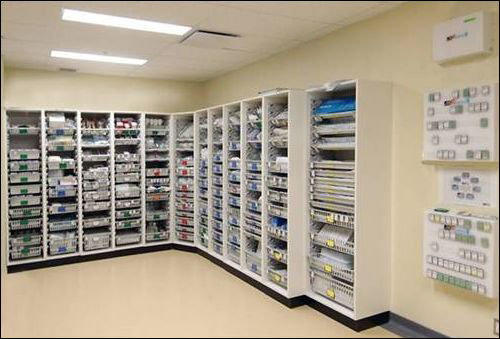Hospitals spend upwards of 30 percent of their total operational budgets on securing and managing consumable medical supplies, according to researchers at the University of Cincinnati (UC), so they pay considerable attention to how these supplies are best managed. Since such items play a crucial role in patient care, many medical facilities tend to overstock nursing stations in order to ensure that these supplies never fall below safe inventory levels—because if that were to happen, an unexpected demand spike could lead to an outage of crucial items. But from a financial perspective, overstocking can also be a problem, as it can lead to over-ordering.
Michael Magazine, a UC professor of operations and business analytics, set out to find a way to improve how hospitals dispense and manage supplies to nursing stations. After conducting a study on the subject, Magazine presented his findings at the Institute for Operations Research and Management Science (INFORMS) Healthcare Conference, held this week in Montreal.
Magazine carried out a study with Claudia Rosales, a just-graduated doctoral student in quantitative analysis now at Michigan State University, and Uday Rao, a UC associate professor of operations and business analytics, to determine how hospitals could optimize the process for nursing stations using a kanban-based resupply system developed by Canadian RFID solutions provider Logi-D. The system, known as 2BIN-iD, features a shelving unit with multiple baskets for storing supplies, as well as a card containing an embedded 13.56 MHz passive RFID tag attached to each basket.
The study was carried out at Magazine’s UC lab, using data collected from hospitals at which the 2BIN-iD system has been deployed. This information, supplied by Logi-D, showed the team the rate at which each type of consumable item was depleted, along with how often each hospital’s staff restocked every item. The team also visited some of those facilities, in order to observe nurses as they removed supplies from the 2BIN-iD baskets, and to observe the employees who restocked them.
The passive RFID tag embedded in each basket’s card is compliant with the ISO 15693 standard, and there are two baskets assigned to every item stocked on the shelves. So, for example, one might find two baskets containing sutures, and each bin might hold 25 sutures when fully stocked. When a nurse takes the last suture from the first basket, positioned in front of the second, he or she removes the empty basket, along with the RFID card clipped to that basket, and then clips this card to a board, also produced by Logi-D. An RFID reader mounted behind the board collects the unique ID number encoded to the card’s tag, and sends this data to Logi-D’s LogiDATA-iD software application, which links the transponder information to the supply database. The software then automatically issues resupply requests to the appropriate personnel, who can unclip the RFID card from the board, affix it to a full basket and place that basket on the shelf.Because the individual supply items—such as sutures, in the example above—tend to be low-cost, and because nurses often use up supplies rather quickly, these items are not good candidates for item-level tagging, due to the costs associated with tagging every item. So from a technology/cost perspective, the 2BIN-iD system is a sound choice for many hospitals, according to Richard Philippe, Logi-D’s president. In fact, he says, it has been deployed at many facilities across Canada.
Magazine first learned about the Logi-D system at a technology conference at which Philippe was a speaker. He then set out to include the solution in his research (which also included other, non-RFID-based supply-management systems).
According to Magazine, Logi-D had already shown, through past deployments, that 2BIN-iD could simplify the resupply logistics while also reducing nurses’ resupply activity by more than 70 percent, compared with conventional resupply systems. But the practice of resupply is still costly, from a labor perspective. So how should the software determine the optimal time to send resupply commands? Should re-supplies be triggered every time a basket is emptied, or when a specified number of baskets turn up bare? And what is the optimal amount for stocking each item in the bins? These are some of the questions that Magazine and his team addressed during their study.
“Hospitals don’t want to put more items [in the stocking units] than the nurses need, because then there might be some hoarding,” Magazine explains, so the hospitals’ logisticians want to be lean when it comes to maintaining nursing-station stock levels. “At the same time, there are real costs associated with material management. If you have 200 items, and you had to send someone out to replenish each time [an empty basket is detected], that would be expensive.”
“The issue we dealt with,” Magazine says, “is, how many tags should we wait to see before we do a replenishment?”Magazine and his colleagues devised a mathematical model to answer that question. This model takes into account such factors as the average number of each type of consumable item that nurses use during given periods, the cost of those supplies, the labor expense associated with restocking them and the safe inventory levels required to ensure that there are always sufficient quantities of items to respond to medical needs. The team then determined which supplies would likely be the next to fall below safe levels, based on historical usage patterns. The mathematical model adds some or all of these items to the resupply order, in order to reduce the number of times that employees would need to resupply items in the near future.
The researchers used this mathematical model to set the business rules—the guides utilized by the software to determine which supplies should be restocked, as well as when this should occur—in the Logi-D application software. In other words, they employed the model to determine when to trigger resupply orders, based on the RFID tags read by the Logi-D board. Based on its analysis, the team determined that hospitals using the mathematical model in conjunction with the 2BIN-iD system could reduce labor costs by 18 percent. Whether that same improvement will bear out in a real-world hospital, however, has yet to be seen.
According to Philippe, Logi-D currently uses “some statistic analysis, based on consumption patterns,” to set the software’s business rules. The UC team’s mathematical model, however, takes many more factors into consideration. Whereas Logi-D might set the business rules to trigger a resupply order every time—for example, three tags are read on the board, based on how quickly a given hospital consumes most of its supplies—the team’s model would also factor in which type of supplies are involved, as well as which other items should also be restocked, in order to make the replenishment process more time- and labor-efficient.
In addition to presenting his findings at this week’s INFORMS Healthcare Conference, Magazine is also meeting with Sacre-Coeur Hospital, in Montreal, which has deployed the 2BIN-iD system but now wants to try to optimize it by applying the model that Magazine and his team developed to set the business rules in the LogiDATA-iD software. What’s more, Magazine and his colleagues are working with another 2BIN-iD user, the Hospital for Sick Children (SickKids), in Toronto, to apply the model as well.
Logi-D, Philippe says, is presently in discussions with the UC team to determine whether the company will utilize the researchers’ mathematical model to set the resupply triggers in the LogiDATA-iD software for other existing and upcoming 2BIN-iD deployments.



